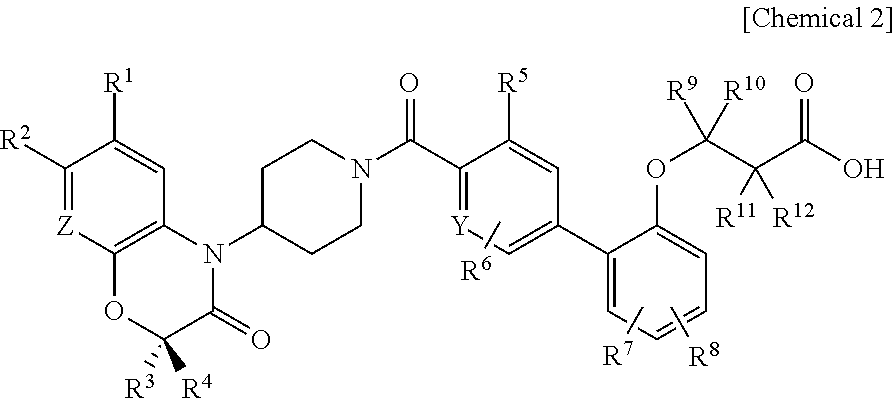3-(biaryloxy)propionic acid derivatives for prevention and/or treatment of thromboembolic diseases
a technology of thromboembolic diseases and propionic acid, which is applied in the direction of biocide, drug composition, extracellular fluid disorder, etc., can solve the problems of poor prognosis and limitations of life, impose a lot of individual or social burden on a patient, and high mortality rates, and achieve excellent suppressive action, excellent suppressive effect, and high safety
- Summary
- Abstract
- Description
- Claims
- Application Information
AI Technical Summary
Benefits of technology
Problems solved by technology
Method used
Image
Examples
reference example 1
7′-Chloro-1′-piperidin-4-ylspiro[cyclopropane-1,3′-pyrido[2,3-b][1,4]oxazine]-2′(1′H)-one trifluoroacetate
[0214]
reference example 1-1
[0215]At room temperature under shielded light, to N,N′-diisopropylcarbodiimide (99.75 g) was added copper(I) chloride (1.57 g), and then tert-butanol (83 ml) was added dropwise over 20 minutes, followed by stirring for 4 days. The supernatant (48 ml) was added dropwise to a dichloromethane suspension (120 ml) of 1-hydroxycyclopropanecarboxylic acid (17.12 g) using an ice bath over 15 minutes. The temperature was brought back to room temperature, followed by stirring for 40 hours, and then acetic acid (11.5 ml) was added and stirred for 1 hour. The reaction suspension was filtered, and ice water and sodium hydrogen carbonate were added to the filtrate for neutralization. After the precipitate was filtered off, the organic layer separated from the filtrate was washed with saturated sodium hydrogen carbonate, dried over anhydrous sodium sulfate, and concentrated under reduced pressure. After pentane was added to the residue, insolubles were filtered off, and the filtrate was concentra...
reference example 1-2
[0217]Under ice cooling, to a toluene suspension (60 ml) of 63% sodium hydride (2.81 g) was added dropwise a toluene solution (30 ml) of tert-butyl 1-hydroxycyclopropanecarboxylate (11.65 g) over 15 minutes, followed by stirring as it stood for 30 minutes, and further at room temperature for 2 hours. After cooling again using an ice bath, a toluene solution (30 ml) of 2,5-dichloro-3-nitropyridine (7.13 g) was added, and the temperature was brought back to room temperature, followed by stirring for 3 hours. After a 10% aqueous citric acid solution was added, the separated organic layer was washed with saturated sodium chloride solution, and the aqueous layer was extracted with ethyl acetate. The collected organic layer was dried over anhydrous sodium sulfate, and concentrated under reduced pressure. The residue was purified by silica gel column chromatography to afford tert-butyl 1-[(5-chloro-3-nitropyridin-2-yl)oxy]cyclopropanecarboxylate (9.61 g).
[0218]1H NMR (500 MHz, CDCl3) δ: 1....
PUM
| Property | Measurement | Unit |
|---|---|---|
| reaction temperature | aaaaa | aaaaa |
| reaction temperature | aaaaa | aaaaa |
| reaction temperature | aaaaa | aaaaa |
Abstract
Description
Claims
Application Information
 Login to View More
Login to View More - R&D
- Intellectual Property
- Life Sciences
- Materials
- Tech Scout
- Unparalleled Data Quality
- Higher Quality Content
- 60% Fewer Hallucinations
Browse by: Latest US Patents, China's latest patents, Technical Efficacy Thesaurus, Application Domain, Technology Topic, Popular Technical Reports.
© 2025 PatSnap. All rights reserved.Legal|Privacy policy|Modern Slavery Act Transparency Statement|Sitemap|About US| Contact US: help@patsnap.com



